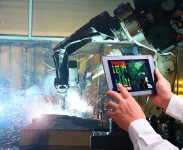(Press-News.org) The basic idea is simple: unlike previous chips, where only calculations were carried out on transistors, they are now the location of data storage as well. That saves time and energy. “As a result, the performance of the chips is also boosted,” says Hussam Amrouch, a professor of AI processor design at the Technical University of Munich (TUM). The transistors on which he performs calculations and stores data measure just 28 nanometers, with millions of them placed on each of the new AI chips. The chips of the future will have to be faster and more efficient than earlier ones. Consequently, they cannot heat up as quickly. This is essential if they are to support such applications as real-time calculations when a drone is in flight, for example. “Tasks like this are extremely complex and energy-hungry for a computer,” explains the professor.
Modern chips: many steps, low energy consumption
These key requirements for a chip are summed up mathematically by the parameter TOPS/W: “tera-operations per second per watt”. This can be seen as the currency for the chips of the future. The question is how many trillion operations (TOP) a processor can perform per second (S) when provided with one watt (W) of power. The new AI chip, developed in a collaboration between Bosch and Fraunhofer IMPS and supported in the production process by the US company GlobalFoundries, can deliver 885 TOPS/W. This makes it twice as powerful as comparable AI chips, including a MRAM chip by Samsung. CMOS chips, which are now commonly used, operate in the range of 10–20 TOPS/W. This is demonstrated in results recently published in Nature.
In-memory computing works like the human brain
The researchers borrowed the principle of modern chip architecture from humans. “In the brain, neurons handle the processing of signals, while synapses are capable of remembering this information,” says Amrouch, describing how people are able to learn and recall complex interrelationships. To do this, the chip uses “ferroelectric” (FeFET) transistors. These are electronic switches that incorporate special additional characteristics (reversal of poles when a voltage is applied) and can store information even when cut off from the power source. In addition, they guarantee the simultaneous storage and processing of data within the transistors. “Now we can build highly efficient chipsets that can be used for such applications as deep learning, generative AI or robotics, for example where data have to be processed where they are generated,” believes Amrouch.
Market-ready chips will require interdisciplinary collaboration
The goal is to use the chip to run deep learning algorithms, recognize objects in space or process data from drones in flight with no time lag. However, the professor from the integrated Munich Institute of Robotics and Machine Intelligence (MIRMI) at TUM believes that it will be a few years before this is achieved. He thinks that it will be three to five years, at the soonest, before the first in-memory chips suitable for real-world applications become available. One reason for this, among others, lies in the security requirements of industry. Before a technology of this kind can be used in the automotive industry, for example, it is not enough for it to function reliably. It also has to meet the specific criteria of the sector. “This again highlights the importance of interdisciplinary collaboration with researchers from various disciplines such as computer science, informatics and electrical engineering,” says the hardware expert Amrouch. He sees this as a special strength of MIRMI.
END
TUM professor develops energy-saving AI chip
In-memory computing
2023-10-26
ELSE PRESS RELEASES FROM THIS DATE:
SETI Institute artist-in-residence Daniela De Paulis to receive 2023 Europlanet Prize for Public Engagement
2023-10-26
SETI Institute Artist-in-Residence Daniela De Paulis to Receive 2023 Europlanet Prize for Public Engagement
Daniela de Paulis is honored for her work bringing space and planetary science to international audiences.
October 26, 2023, Mountain View, CA -- The SETI Institute is thrilled to announce that Daniela De Paulis, a SETI Artist-in-Residence (SETI AIR), will be honored with the prestigious 2023 Europlanet Prize for Public Engagement. De Paulis’ groundbreaking project, ‘A Sign in Space,’ invited a global audience to participate in decoding a simulated message from an extraterrestrial ...
Genomic screening to identify iron overload encourages patients to seek treatment and condition management, study finds
2023-10-26
DANVILLE, Pa. – Genomic screening to identify hemochromatosis—a disorder that causes iron levels in the body to rise to dangerous levels—encourages people with the condition to seek treatment and ongoing management, a Geisinger study found.
Hereditary hemochromatosis type 1 (HH1), caused by a change in the HFE gene, is underdiagnosed, often resulting in missed opportunities for early and consistent treatment. Without treatment, hemochromatosis can cause iron overload, a buildup of iron that can damage many parts of the body. Treatment of hemochromatosis includes regular monitoring of iron levels and removing excess iron ...
People with autism less likely to succumb to bystander effect, York University father-son research duo finds
2023-10-26
People with autism less likely to succumb to bystander effect, York U father-son research duo finds
Schulich School of Business and Faculty of Health researchers say that while as many as 90 per cent of people with autism are unemployed or underemployed, their study points to the benefits of having neurodivergent people in the workplace
TORONTO, Oct. 26, 2023 — A well-established psychological theory states that most of us are less likely to intervene in a bad situation if other people are present, and this ‘bystander effect’ also applies to workplace settings. However, new research led ...
UTSA receives $500,000 US Economic Development Administration grant to build secure manufacturing hub in South Texas
2023-10-26
(San Antonio, October 26, 2023) -- The Cybersecurity Manufacturing Innovation Institute (CyManII) at The University of Texas at San Antonio (UTSA) has been selected by the U.S. Economic Development Administration (EDA) to establish an ecosystem that will promote secure manufacturing strategies across South Texas. The Secure Manufacturing in South Texas Strategy Development Consortium, funded by a $500,000 Tech Hubs Strategy Development Grant, will enable CyManII to take initial steps to develop a Secure Manufacturing Tech Hub that will mature technologies, enhance business competitiveness ...
Asian American Engineer of the Year goes to Sandia Labs computer scientist
2023-10-26
ALBUQUERQUE, N.M. — Tian Ma, a distinguished computer engineer in research and development at Sandia National Laboratories, has been honored as a 2023 Asian American Engineer of the Year by the Chinese Institute of Engineers-USA. Each year, CIE recognizes exceptional Asian American engineers who demonstrate strong technical skills, leadership abilities and a commitment to public service. Previous recipients of this award include Nobel laureates and astronauts.
Ma’s expertise in data analysis and processing has propelled him to national recognition as an expert in detection algorithms and tracking systems. His journey ...
Venus had Earth-like plate tectonics billions of years ago, study suggests
2023-10-26
PROVIDENCE, R.I. [Brown University] — Venus, a scorching wasteland of a planet according to scientists, may have once had tectonic plate movements similar to those believed to have occurred on early Earth, a new study found. The finding sets up tantalizing scenarios regarding the possibility of early life on Venus, its evolutionary past and the history of the solar system.
Writing in Nature Astronomy, a team of scientists led by Brown University researchers describes using atmospheric data from Venus and computer modeling to show that the composition of the planet’s current atmosphere and surface pressure would only have been possible as a result of an early form of plate ...
Machine learning study looks at younger population to identify, mitigate cardiometabolic risks
2023-10-26
BINGHAMTON, N.Y. -- A researcher at Binghamton University, State University of New York will lead a $2.5 million project from the National Institutes of Health to develop machine models to identify and predict cardiometabolic risks in adolescents and young adults.
Cardiometabolic diseases are the top cause of preventable deaths worldwide, and the number of people who experience one or more of these conditions during their lifetime is increasing.
Still, much of the research about these diseases has focused on the adult and senior populations. What if younger people and the healthcare professionals who ...
Study seeks new treatments for post-traumatic stress disorder in veterans, military personnel
2023-10-26
A groundbreaking clinical trial launched October 16 will explore the promise of new drug treatments for military personnel and veterans suffering from post-traumatic stress disorder (PTSD). The multi-site trial is spearheaded by the U.S. Army Medical Materiel Development Activity (USAMMDA), part of the U.S. Army Medical Research and Development Command, and supported by a project team that includes representatives from the U.S. Air Force, Army, Navy, and Special Operations Command.
Military veterans are more likely to have PTSD than civilians, according to statistics from the U.S. Department of Veterans Affairs, and service members who deployed to ...
Scientists call for a major investigation into Congo Basin
2023-10-26
Leading researchers have launched a major scientific initiative to investigate - and help protect - the fragile Congo Basin Forest region in central Africa, one of the world’s most important but little understood ecosystems.
They say the Congo Basin Science Initiative will transform the understanding of the Congo Basin, an area of 240 million hectares of contiguous tropical forests that absorb a vast quantity of carbon, which helps to moderate the impact of global climate ...
Politecnico di Milano and Università di Milano-Bicocca awarded an ERC Synergy Grant on next-generation numerical methods for sustainability challenges
2023-10-26
Developing new-generation numerical methods for the technological challenges of the 21st century, mainly in sustainability. This is the objective underpinning NEMESIS (NEw GEneration MEthods for Numerical SImulationS), an international researchproject involving Politecnico di Milano and Università di Milano-Bicocca, which today has been awarded one of the 37 Synergy Grants by the European Research Council (ERC). ERC Synergy Grants fund research on topics that are ambitious and complex ...
LAST 30 PRESS RELEASES:
Interaction of climate change and human activity and its impact on plant diversity in Qinghai-Tibet plateau
From addressing uncertainty to national strategy: an interpretation of Professor Lim Siong Guan’s views
Clinical trials on AI language model use in digestive healthcare
Scientists improve robotic visual–inertial trajectory localization accuracy using cross-modal interaction and selection techniques
Correlation between cancer cachexia and immune-related adverse events in HCC
Human adipose tissue: a new source for functional organoids
Metro lines double as freight highways during off-peak hours, Beijing study shows
Biomedical functions and applications of nanomaterials in tumor diagnosis and treatment: perspectives from ophthalmic oncology
3D imaging unveils how passivation improves perovskite solar cell performance
Enriching framework Al sites in 8-membered rings of Cu-SSZ-39 zeolite to enhance low-temperature ammonia selective catalytic reduction performance
AI-powered RNA drug development: a new frontier in therapeutics
Decoupling the HOR enhancement on PtRu: Dynamically matching interfacial water to reaction coordinates
Sulfur isn’t poisonous when it synergistically acts with phosphine in olefins hydroformylation
URI researchers uncover molecular mechanisms behind speciation in corals
Chitin based carbon aerogel offers a cleaner way to store thermal energy
Tracing hidden sources of nitrate pollution in rapidly changing rural urban landscapes
Viruses on plastic pollution may quietly accelerate the spread of antibiotic resistance
Three UH Rainbow Babies & Children’s faculty elected to prestigious American Pediatric Society
Tunnel resilience models unveiled to aid post-earthquake recovery
Satellite communication systems: the future of 5G/6G connectivity
Space computing power networks: a new frontier for satellite technologies
Experiments advance potential of protein that makes hydrogen sulfide as a therapeutic target for Alzheimer’s disease
Examining private equity’s role in fertility care
Current Molecular Pharmacology achieves a landmark: real-time CiteScore advances to 7.2
Skeletal muscle epigenetic clocks developed using postmortem tissue from an Asian population
Estimating unemployment rates with social media data
Climate policies can backfire by eroding “green” values, study finds
Too much screen time too soon? A*STAR study links infant screen exposure to brain changes and teen anxiety
Global psychiatry mourns Professor Dan Stein, visionary who transformed mental health science across Africa and beyond
KIST develops eco-friendly palladium recovery technology to safeguard resource security
[Press-News.org] TUM professor develops energy-saving AI chipIn-memory computing






